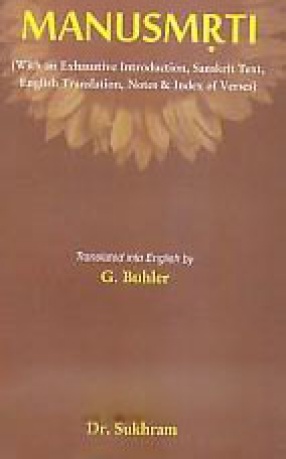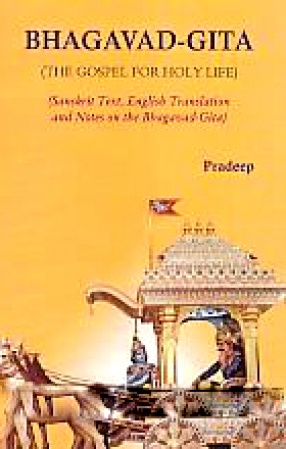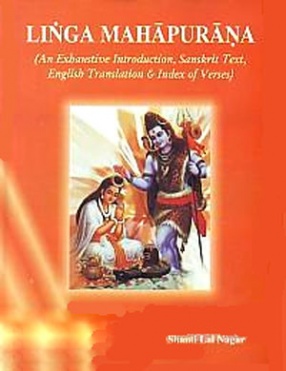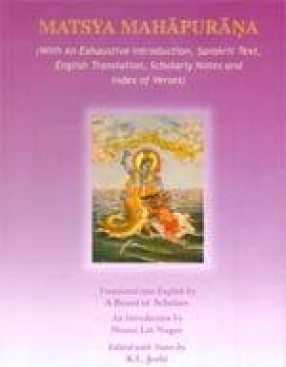
Parimal Sanskrit Series

25 books
















The volume is concerned with the Brhajjatakam (sixth century AD) by Varaha Mihira who is regarded as unparalleled in his knowledge of astronomy and geography in ancient India. The work is considered as one of the most authoritative treatises on the science of Hindu horoscopy. The present edition includes the Sanskrit text of Brhajjatakam along with an English translation which is supported with various examples and notes. There is an index of verses at the end ...


The Original Bhagavad Gita contains the rare verses and the total number of verses in it is 745, which is in confornity with the Gitamana verse of the Bhishma parva of the Mahabharata. A millennium ago Abhinavagupta included some rare verse in his commently on the Bhagavad Gita. The Kashmiri version of the Bhagavad Gita brought out by Schraeder in the early last century contained rare verses. The book, published by the Gondal pith, based on an ancient manuscript ...


The Puranas are invaluable and significant sources of Indian culture. The Pauranic tradition preserves different aspects of Indian religions practies, philosophical musings, literary developments and cultural expressions. The development of the Puranas had been simultaneous with the development of Indian cultural. They may be regarded as the ever-developing encyclopaedia of Indian culture.
The Sun-worship is an ancient tradition of India which originated in the ...





Jayarasi Bhatta’s “Tattvopaplavasimha’ is a rare piece of work on Indian Skepticism. Its author has boldly criticized the means of valid knowledge affirmed by the various systems of Indian thought, namely Carvaka, Nyaya, Samkhya, Mimamsa, Vedanta, Buddhist and Jain respectively by declaring the annihilation of all the principles. Although the tradition links it with the Carvaka system of thought, its study leads a reader toward a skeptical ...



The present edition of Yajurveda with English version of Mahidhara and Uvata's commentary by Griffith has become conspicuous with the following salient features-(1) The old usage of English version has been replaced by the corresponding modern usage in order that the contents of the translation may be easily made out even by a layman. For instance, the old pronominal forms like thy, thou, thee, thine, etc. have been replaced by the corresponding terms in modern ...

The present edition of Rgveda has become conspicous with the following features: The present edition contains original text of Rgveda in Devanagari Script alongwith English translation of Wilson which is based solely upon Sayana Bhasya. The old-English usage of Wilson's translation has been updated and revised. With the revised usage, translation may be easily understood even by a lay scholar. For instance, old English pronominal forms like thee, thou, thy, thine ...

All religions define a final goal of life and prescribe methods by means of which that goal may be obtained. To a Hindu, the ultimate goal is the realization that the only real thing is the Supreme Brahman, that the world is an illusion, that the Absolute Self and the individual self are identical and that salvation consists in nothing more than the lightening flash which reveals this identity. Hindu religious texts have laid down several means by which this end ...

The Yoga or contemplative philosophy of the Hindus is rich, exuberant, grand and sublime, in as much as it comprehends within its ample sphere and deep recesses of meditation, all that is of the greatest value, best interest and highest importance to mankind as physical, moral, intellectual and spiritual beings-a knowledge of the cosmos-of the physical and intellectual worlds. The principal Gods Brahma and Siva are represented as Yogis, the chief sages Vyasa, ...

The Markandeya Purana is a famous one amongst the eighteen Mahapuranas. This Purana has a character different from that of all the others. It has nothing of a sectarial spirit, little of a religious tone; rarely inserting prayers and invocations to any deity; and such as are inserted are brief and moderate. It deals little in percepts, ceremonial or moral. Its leading feature is narrative; and it presents an uninterrupted succession of legends, most of which when ...

The Vedas are the most important records of the religion and the institutions of the Aryans. The last and the latest Veda is the Atharvaveda, which is addressed with many other names such as- Amritaveda, Atmaveda, Angiro Veda, Atharvangirasa, Bhrigvangirasa, Kshatra, Bhaishajya and Chandoveda, etc.Atharvaveda describes the application of both type of ceremonies viz., peaceful affirmation and the witchcraft (Abhicarika) ceremonies. The most cryptic mysteries of ...

Yogasarasamgraha is an original work of Vijanabhiksu. It is the form of collected theories of Yogasutras or Yoga treatise. When deities and demons had churned the ocean they used Sumeru mountain as the churning rod in the process. From that churning, nectar came out and lord Visnu kept it in a jar. Likewise, Vijnanbhiksu has accepted Yoga as an ocean and the commentary Yogavarttika as the churning rod. He kept the originating of nectar (subject-matter), which ...

Sri Bhojadeva was first and foremost a man of great learning, a versatile scholar, a polymath indeed, for he has been credited with works in almost every branch of knowledge. According to Ajada who wrtote a commentary named Padakaprakasa on Sarasvati Kanthabharana, Bhoja wrote 84 works giving them names with his own titles and binds. Of the various works ascribed to him, Samarangana Sutradhara is a voluminous treatise, an architectural masterpiece, dealing with ...

The Matsya Purana earns its title from the fish incarnation of Visnu, the other nine being Kurma, varaha, Narasimha, Vamana. Bhargava Parasurama, Rama, Krsna, Buddhaand Kalki. The Matsya Purana is not all based totally on the life story of Matsya, but it deals with various other subjects, through in some of the chapters Matsya himself is the speaker. Matsya Purana contains 291 chapters in total. First among all it describes the dialogues between Manu and the ...

The Brhatkatha Sloka Samgraha of Buddhasvamin considered to be one of the Sanskrit redactionso f the Brhatkatha of Gunadhya in Cantos 28 displays altogether a different norm of descriptive delineation as compound to the contents of the other two versions e.g. Brhatkathamanjari of the prolific writer Ksemendra and Somadeva's Kathasarit Sagara both having eighteen Lambakas subdivided into gucchas and tarangas respectively. The Poem begins with an ...

Mandaramanjari of Vishveshvara Pandeya, author of Aryasaptashati and many other works on Alankarashastra is only in Purvabhaga, the Uttarabhaga said to have been written by his son not traceable.According to Dr. V.V. Bhatta, Mandaramanjari like Kadambari deals with the two Romances of Puspupura King Citrabhanu son of Rajashekhara and Malaykavati and Mandaramanjari on the one hand and of the Demon Manasaketu and Madayantika like Bana’s Candriapida and ...

The Purana is a distinct branch of learning. It is treated as one of the Vidyas like the Samkhya and the Vedanta, it has its distinct theory of cosmology. The major Puranas are considered to be eighteen in numbers, known by Maha-puranas. One of the important Purana among the eighteen Maha-puranas is Kurma Mahapurana, in which the narrator is Lord Visnu himself, in the form of a Kurma (tortoise). Kurma Purana is divided into two sections, viz., Purva-bhaga and ...
